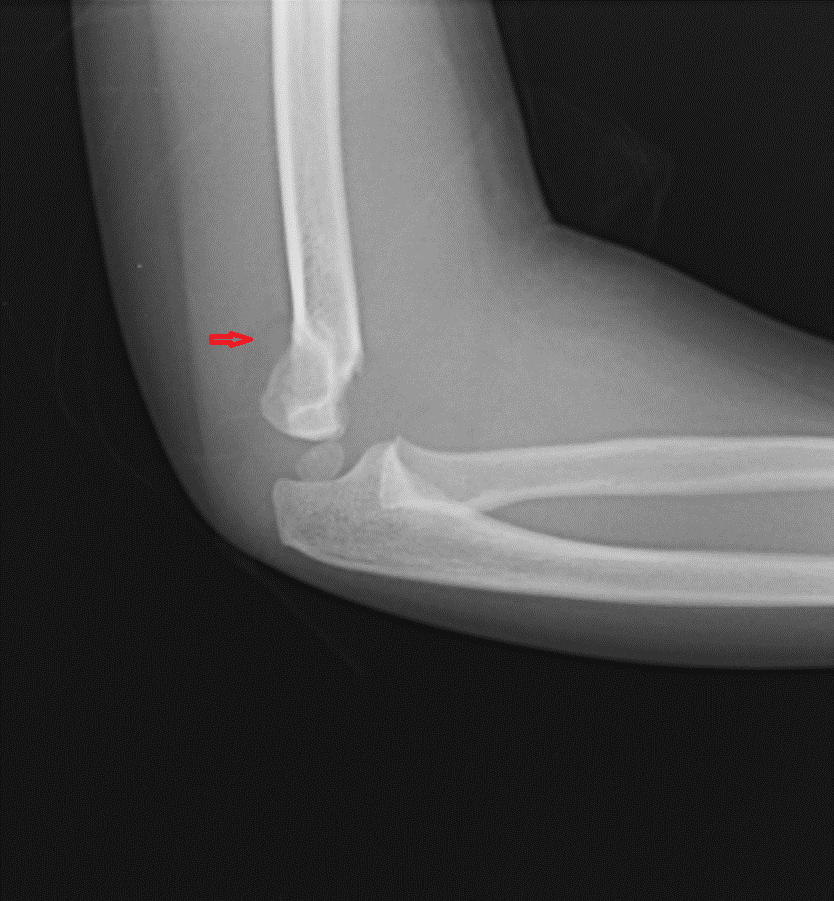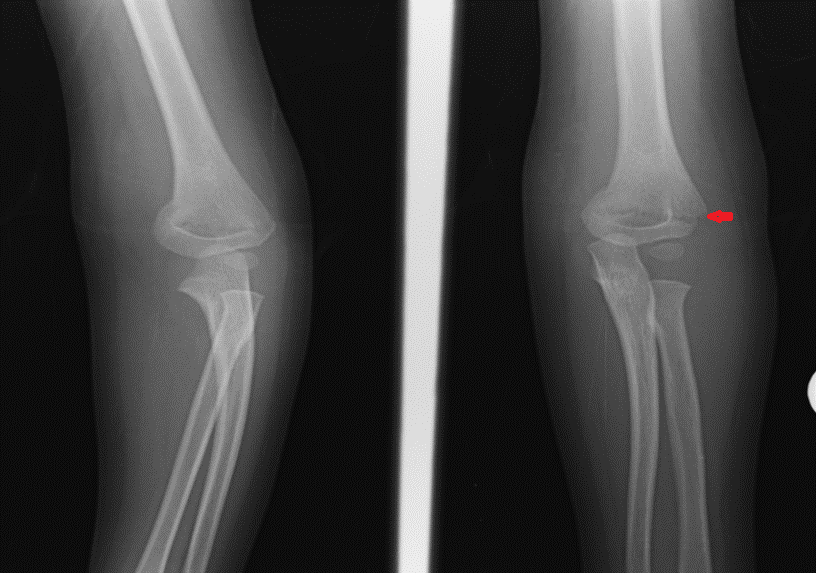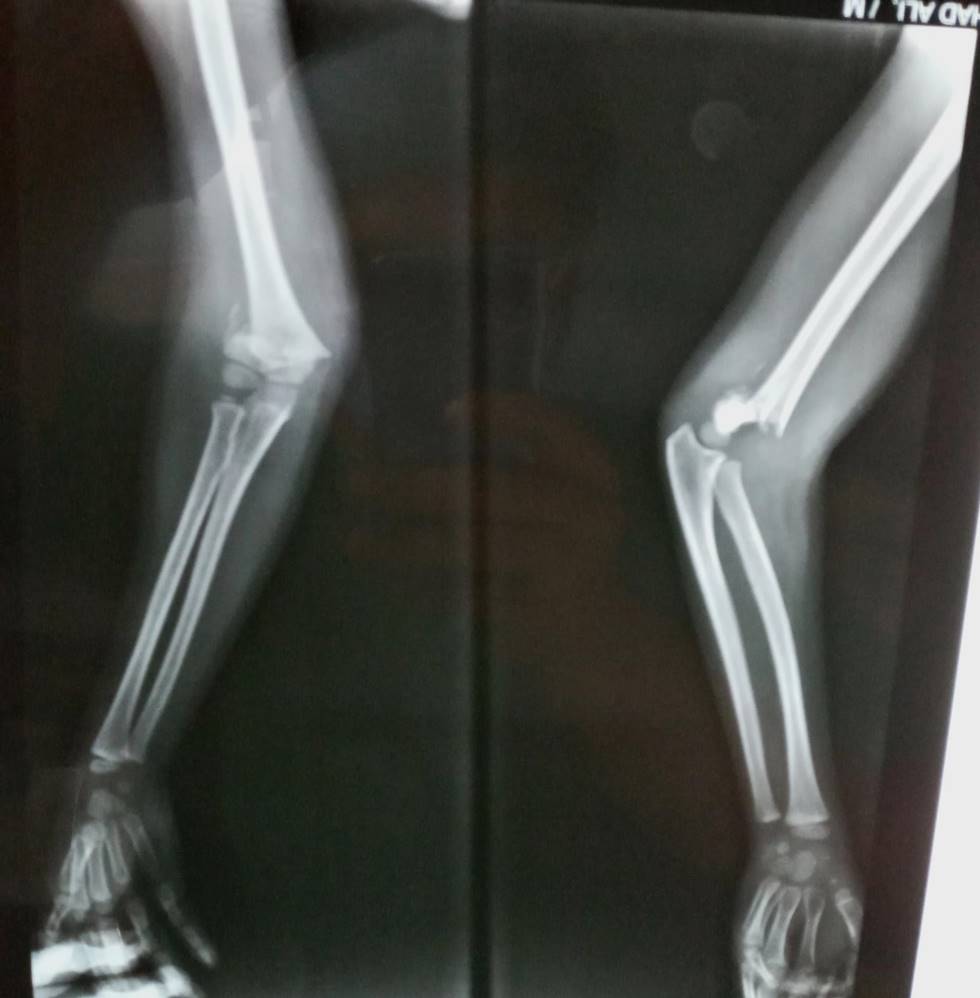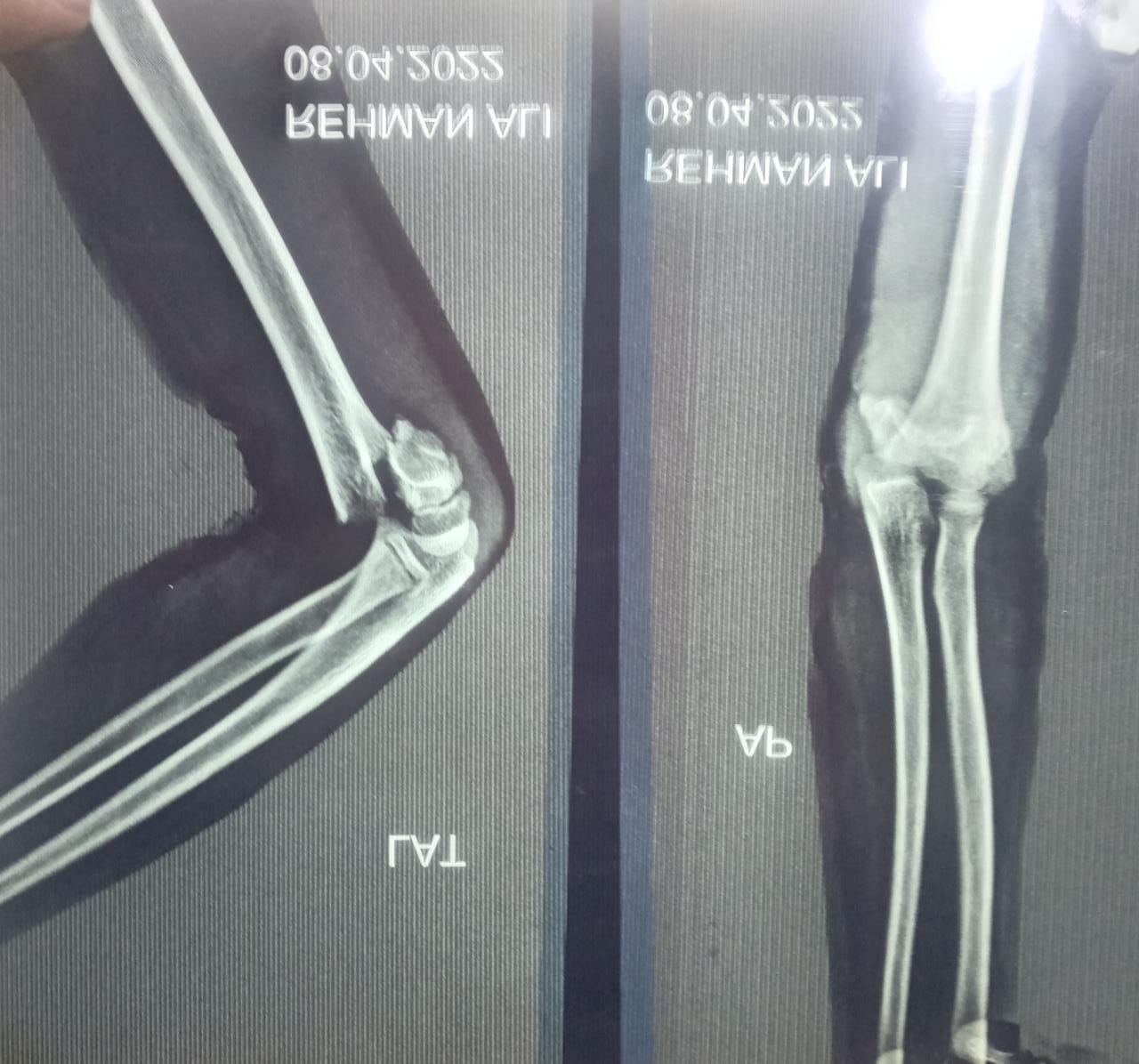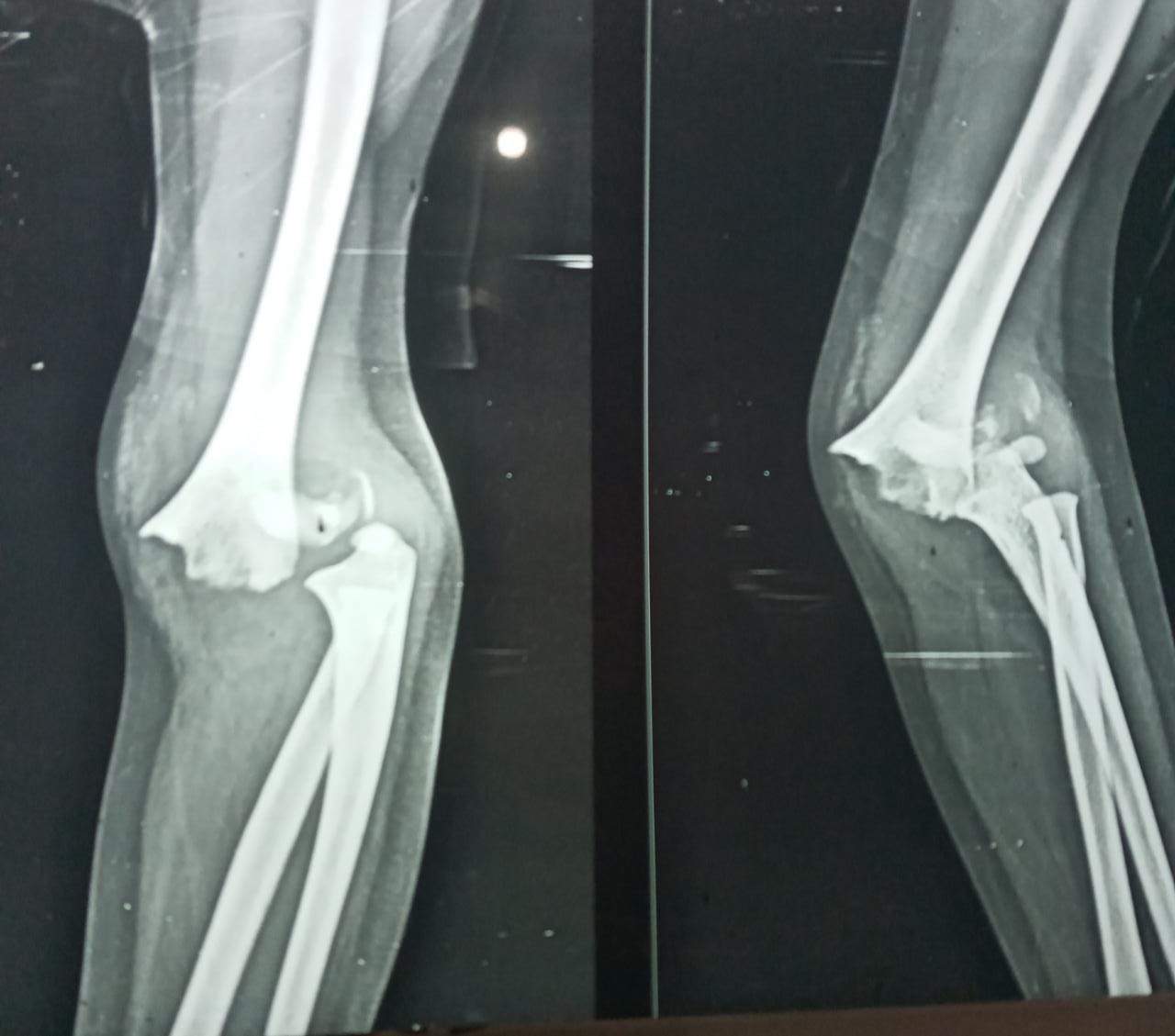[1]
Shenoy PM,Islam A,Puri R, Current Management of Paediatric Supracondylar Fractures of the Humerus. Cureus. 2020 May 15
[PubMed PMID: 32550057]
[2]
Leung S,Paryavi E,Herman MJ,Sponseller PD,Abzug JM, Does the Modified Gartland Classification Clarify Decision Making? Journal of pediatric orthopedics. 2018 Jan;
[PubMed PMID: 26974527]
[3]
Tomaszewski R,Wozowicz A,Wysocka-Wojakiewicz P, Analysis of Early Neurovascular Complications of Pediatric Supracondylar Humerus Fractures: A Long-Term Observation. BioMed research international. 2017;
[PubMed PMID: 28367440]
[4]
Pannu GS,Eberson CP,Abzug J,Horn BD,Bae DS,Herman M, Common Errors in the Management of Pediatric Supracondylar Humerus Fractures and Lateral Condyle Fractures. Instructional course lectures. 2016;
[PubMed PMID: 27049207]
[5]
Moraleda L,Valencia M,Barco R,González-Moran G, Natural history of unreduced Gartland type-II supracondylar fractures of the humerus in children: a two to thirteen-year follow-up study. The Journal of bone and joint surgery. American volume. 2013 Jan 2;
[PubMed PMID: 23405411]
[8]
Barr LV, Paediatric supracondylar humeral fractures: epidemiology, mechanisms and incidence during school holidays. Journal of children's orthopaedics. 2014 Mar;
[PubMed PMID: 24643672]
[9]
Landin LA,Danielsson LG, Elbow fractures in children. An epidemiological analysis of 589 cases. Acta orthopaedica Scandinavica. 1986 Aug
[PubMed PMID: 3788491]
Level 2 (mid-level) evidence
[10]
Farnsworth CL,Silva PD,Mubarak SJ, Etiology of supracondylar humerus fractures. Journal of pediatric orthopedics. 1998 Jan-Feb
[PubMed PMID: 9449099]
[11]
Holt JB,Glass NA,Shah AS, Understanding the Epidemiology of Pediatric Supracondylar Humeral Fractures in the United States: Identifying Opportunities for Intervention. Journal of pediatric orthopedics. 2018 May/Jun;
[PubMed PMID: 29462120]
Level 3 (low-level) evidence
[13]
Nork SE,Hennrikus WL,Loncarich DP,Gillingham BL,Lapinsky AS, Relationship between ligamentous laxity and the site of upper extremity fractures in children: extension supracondylar fracture versus distal forearm fracture. Journal of pediatric orthopedics. Part B. 1999 Apr
[PubMed PMID: 10218167]
[14]
Anjum R,Sharma V,Jindal R,Singh TP,Rathee N, Epidemiologic pattern of paediatric supracondylar fractures of humerus in a teaching hospital of rural India: A prospective study of 263 cases. Chinese journal of traumatology = Zhonghua chuang shang za zhi. 2017 Jun;
[PubMed PMID: 28511800]
Level 3 (low-level) evidence
[15]
Abraham E,Powers T,Witt P,Ray RD, Experimental hyperextension supracondylar fractures in monkeys. Clinical orthopaedics and related research. 1982 Nov-Dec
[PubMed PMID: 6814805]
[16]
Duffy S,Flannery O,Gelfer Y,Monsell F, Overview of the contemporary management of supracondylar humeral fractures in children. European journal of orthopaedic surgery & traumatology : orthopedie traumatologie. 2021 Jul
[PubMed PMID: 33744996]
Level 3 (low-level) evidence
[17]
Smuin D,Hatch M,Winthrop Z,Gidvani S,Hennrikus W, The Reduction Maneuver for Pediatric Extension Type 3 Supracondylar Humerus Fractures. Cureus. 2020 Jul 15
[PubMed PMID: 32821565]
[18]
Flaherty EG,Perez-Rossello JM,Levine MA,Hennrikus WL,American Academy of Pediatrics Committee on Child Abuse and Neglect,Section on Radiology, American Academy of Pediatrics,Section on Endocrinology, American Academy of Pediatrics,Section on Orthopaedics, American Academy of Pediatrics,Society for Pediatric Radiology, Evaluating children with fractures for child physical abuse. Pediatrics. 2014 Feb
[PubMed PMID: 24470642]
[19]
Smuin DM,Hennrikus WL, The Effect of the Pucker Sign on Outcomes of Type III Extension Supracondylar Fractures in Children. Journal of pediatric orthopedics. 2017 Jun
[PubMed PMID: 27776053]
[20]
Babal JC,Mehlman CT,Klein G, Nerve injuries associated with pediatric supracondylar humeral fractures: a meta-analysis. Journal of pediatric orthopedics. 2010 Apr-May;
[PubMed PMID: 20357592]
Level 1 (high-level) evidence
[21]
Campbell CC,Waters PM,Emans JB,Kasser JR,Millis MB, Neurovascular injury and displacement in type III supracondylar humerus fractures. Journal of pediatric orthopedics. 1995 Jan-Feb;
[PubMed PMID: 7883927]
[22]
Mangat KS,Martin AG,Bache CE, The 'pulseless pink' hand after supracondylar fracture of the humerus in children: the predictive value of nerve palsy. The Journal of bone and joint surgery. British volume. 2009 Nov;
[PubMed PMID: 19880900]
[23]
Miyazaki CS,Maranho DA,Agnollitto PM,Nogueira-Barbosa MH, STUDY OF SECONDARY OSSIFICATION CENTERS OF THE ELBOW IN THE BRAZILIAN POPULATION. Acta ortopedica brasileira. 2017 Nov-Dec;
[PubMed PMID: 29375260]
[24]
Williamson DM,Coates CJ,Miller RK,Cole WG, Normal characteristics of the Baumann (humerocapitellar) angle: an aid in assessment of supracondylar fractures. Journal of pediatric orthopedics. 1992 Sep-Oct
[PubMed PMID: 1517426]
[25]
Smajic N,Smajic J,Sadic S,Jasarevic M,Ahmetovic-Djug J,Hodzic R, Correlation between Bauman's and carrying angle in children with supracondylar fracture of humerus. Medical archives (Sarajevo, Bosnia and Herzegovina). 2013
[PubMed PMID: 23848042]
[26]
Silva M,Pandarinath R,Farng E,Park S,Caneda C,Fong YJ,Penman A, Inter- and intra-observer reliability of the Baumann angle of the humerus in children with supracondylar humeral fractures. International orthopaedics. 2010 Apr
[PubMed PMID: 19424695]
[27]
Samelis PV,Papagrigorakis E,Ellinas S, Role of the Posterior Fat Pad Sign in Treating Displaced Extension Type Supracondylar Fractures of the Pediatric Elbow Using the Blount Method. Cureus. 2019 Oct 29
[PubMed PMID: 31824792]
[28]
Herman MJ,Boardman MJ,Hoover JR,Chafetz RS, Relationship of the anterior humeral line to the capitellar ossific nucleus: variability with age. The Journal of bone and joint surgery. American volume. 2009 Sep
[PubMed PMID: 19723996]
[29]
Abzug JM,Herman MJ, Management of supracondylar humerus fractures in children: current concepts. The Journal of the American Academy of Orthopaedic Surgeons. 2012 Feb
[PubMed PMID: 22302444]
[30]
Shaw BA,Kasser JR,Emans JB,Rand FF, Management of vascular injuries in displaced supracondylar humerus fractures without arteriography. Journal of orthopaedic trauma. 1990;
[PubMed PMID: 2313426]
[31]
Omid R,Choi PD,Skaggs DL, Supracondylar humeral fractures in children. The Journal of bone and joint surgery. American volume. 2008 May;
[PubMed PMID: 18451407]
[33]
Alton TB,Werner SE,Gee AO, Classifications in brief: the Gartland classification of supracondylar humerus fractures. Clinical orthopaedics and related research. 2015 Feb;
[PubMed PMID: 25361847]
[34]
Leitch KK,Kay RM,Femino JD,Tolo VT,Storer SK,Skaggs DL, Treatment of multidirectionally unstable supracondylar humeral fractures in children. A modified Gartland type-IV fracture. The Journal of bone and joint surgery. American volume. 2006 May;
[PubMed PMID: 16651572]
[35]
Labelle H,Bunnell WP,Duhaime M,Poitras B, Cubitus varus deformity following supracondylar fractures of the humerus in children. Journal of pediatric orthopedics. 1982;
[PubMed PMID: 7161389]
[36]
Battaglia TC,Armstrong DG,Schwend RM, Factors affecting forearm compartment pressures in children with supracondylar fractures of the humerus. Journal of pediatric orthopedics. 2002 Jul-Aug;
[PubMed PMID: 12131436]
[37]
Ballal MS,Garg NK,Bass A,Bruce CE, Comparison between collar and cuffs and above elbow back slabs in the initial treatment of Gartland type I supracondylar humerus fractures. Journal of pediatric orthopedics. Part B. 2008 Mar;
[PubMed PMID: 18510158]
[38]
Jones D, Transcondylar fractures of the humerus in children: definition of an acceptable reduction. Proceedings of the Royal Society of Medicine. 1977 Sep;
[PubMed PMID: 918083]
[39]
Yeomans D,Graham SM,Mkandawire NC,Harrison WJ,Perry DC, Conservative management of displaced paediatric supracondylar fractures: a systematic review. Tropical doctor. 2018 Oct;
[PubMed PMID: 30153770]
Level 1 (high-level) evidence
[40]
Novais EN,Andrade MA,Gomes DC, The use of a joystick technique facilitates closed reduction and percutaneous fixation of multidirectionally unstable supracondylar humeral fractures in children. Journal of pediatric orthopedics. 2013 Jan;
[PubMed PMID: 23232373]
[41]
Lee SS,Mahar AT,Miesen D,Newton PO, Displaced pediatric supracondylar humerus fractures: biomechanical analysis of percutaneous pinning techniques. Journal of pediatric orthopedics. 2002 Jul-Aug;
[PubMed PMID: 12131437]
[42]
Gottschalk HP,Sagoo D,Glaser D,Doan J,Edmonds EW,Schlechter J, Biomechanical analysis of pin placement for pediatric supracondylar humerus fractures: does starting point, pin size, and number matter? Journal of pediatric orthopedics. 2012 Jul-Aug;
[PubMed PMID: 22706457]
[43]
Kasirajan S,Govindasamy R,Sathish BRJ,Meleppuram JJ, Trans-olecranon fossa four-cortex purchase lateral pinning in displaced supracondylar fracture of the humerus - a prospective analysis in 48 children. Revista brasileira de ortopedia. 2018 May-Jun;
[PubMed PMID: 29892587]
[44]
Zionts LE,McKellop HA,Hathaway R, Torsional strength of pin configurations used to fix supracondylar fractures of the humerus in children. The Journal of bone and joint surgery. American volume. 1994 Feb;
[PubMed PMID: 8113261]
[45]
Green DW,Widmann RF,Frank JS,Gardner MJ, Low incidence of ulnar nerve injury with crossed pin placement for pediatric supracondylar humerus fractures using a mini-open technique. Journal of orthopaedic trauma. 2005 Mar;
[PubMed PMID: 15758668]
[46]
Vaquero-Picado A,González-Morán G,Moraleda L, Management of supracondylar fractures of the humerus in children. EFORT open reviews. 2018 Oct;
[PubMed PMID: 30662761]
[47]
Koudstaal MJ,De Ridder VA,De Lange S,Ulrich C, Pediatric supracondylar humerus fractures: the anterior approach. Journal of orthopaedic trauma. 2002 Jul;
[PubMed PMID: 12142829]
[48]
Ersan O,Gonen E,İlhan RD,Boysan E,Ates Y, Comparison of anterior and lateral approaches in the treatment of extension-type supracondylar humerus fractures in children. Journal of pediatric orthopedics. Part B. 2012 Mar;
[PubMed PMID: 22158013]
[49]
Cambon-Binder A,Jehanno P,Tribout L,Valenti P,Simon AL,Ilharreborde B,Mazda K, Pulseless supracondylar humeral fractures in children: vascular complications in a ten year series. International orthopaedics. 2018 Apr;
[PubMed PMID: 29192344]
[50]
Ramesh P,Avadhani A,Shetty AP,Dheenadhayalan J,Rajasekaran S, Management of acute 'pink pulseless' hand in pediatric supracondylar fractures of the humerus. Journal of pediatric orthopedics. Part B. 2011 May;
[PubMed PMID: 21164361]
[51]
Weller A,Garg S,Larson AN,Fletcher ND,Schiller JR,Kwon M,Copley LA,Browne R,Ho CA, Management of the pediatric pulseless supracondylar humeral fracture: is vascular exploration necessary? The Journal of bone and joint surgery. American volume. 2013 Nov 6;
[PubMed PMID: 24196459]
[52]
Chang CH,Kao HK,Lee WC,Yang WE, Influence of obesity on surgical outcomes in type III paediatric supracondylar humeral fractures. Injury. 2015 Nov;
[PubMed PMID: 26429104]
[53]
Seeley MA,Gagnier JJ,Srinivasan RC,Hensinger RN,VanderHave KL,Farley FA,Caird MS, Obesity and its effects on pediatric supracondylar humeral fractures. The Journal of bone and joint surgery. American volume. 2014 Feb 5;
[PubMed PMID: 24500590]
[54]
Wang SI,Kwon TY,Hwang HP,Kim JR, Functional outcomes of Gartland III supracondylar humerus fractures with early neurovascular complications in children: A retrospective observational study. Medicine. 2017 Jun;
[PubMed PMID: 28640089]
Level 2 (mid-level) evidence
[55]
Blakey CM,Biant LC,Birch R, Ischaemia and the pink, pulseless hand complicating supracondylar fractures of the humerus in childhood: long-term follow-up. The Journal of bone and joint surgery. British volume. 2009 Nov;
[PubMed PMID: 19880895]
[56]
Bender J,Busch CA, Results of treatment of supracondylar fractures of the humerus in children with special reference to the cause and prevention of cubitus varus. Archivum chirurgicum Neerlandicum. 1978;
[PubMed PMID: 655730]
[57]
Zionts LE,Woodson CJ,Manjra N,Zalavras C, Time of return of elbow motion after percutaneous pinning of pediatric supracondylar humerus fractures. Clinical orthopaedics and related research. 2009 Aug;
[PubMed PMID: 19198963]
[58]
Spencer HT,Wong M,Fong YJ,Penman A,Silva M, Prospective longitudinal evaluation of elbow motion following pediatric supracondylar humeral fractures. The Journal of bone and joint surgery. American volume. 2010 Apr;
[PubMed PMID: 20360514]
[59]
Schmale GA,Mazor S,Mercer LD,Bompadre V, Lack of Benefit of Physical Therapy on Function Following Supracondylar Humeral Fracture: A Randomized Controlled Trial. The Journal of bone and joint surgery. American volume. 2014 Jun 4;
[PubMed PMID: 24897743]
Level 1 (high-level) evidence
[60]
Woo BFY,Lee JXY,Tam WWS, The impact of the advanced practice nursing role on quality of care, clinical outcomes, patient satisfaction, and cost in the emergency and critical care settings: a systematic review. Human resources for health. 2017 Sep 11;
[PubMed PMID: 28893270]
Level 2 (mid-level) evidence
[61]
Brown C,Neep MJ,Pozzias E,McPhail SM, Reducing risk in the emergency department: a 12-month prospective longitudinal study of radiographer preliminary image evaluations. Journal of medical radiation sciences. 2019 Sep;
[PubMed PMID: 31449740]
[62]
Porter RN,Chafe RE,Newhook LA,Murnaghan KD, Multiple interventions improve analgesic treatment of supracondylar humerus fractures in a pediatric emergency department. Pain research
[PubMed PMID: 26125193]

